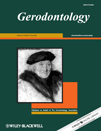Unnoticed ingestion of dislodged fixed prosthesis in an elderly patient
Abstract
doi: 10.1111/j.1741-2358.2010.00408.x Unnoticed ingestion of dislodged fixed prosthesis in an elderly patient
Ageing may directly or indirectly increase the risk of oral diseases and tooth loss, compounded by poor general health, illnesses, or chronic diseases. Elderly patients also have been known to swallow their own dental prostheses due to impairment of oral health and mental health1. Accordingly, sensory impairments such as olfactory and gustatory dysfunction and oral motor problems in mastication, speech, and swallowing may increase the risk of unnoticed swallowing2. We report a patient who ingested a dislodged prosthesis without realising this had occurred. A 72-year-old woman was admitted without any complaint and had no remarkable health problem except hypertension. She stated that she had noticed the absence of her dental prosthesis in the early morning, 10 h after she had eaten dinner. Although she and her family members living with her had looked for it everywhere in the house, they had been unable to find it. A plain X-ray showed an opacity in the upper abdomen. The first upper gastrointestinal endoscopic examination was unsuccessful as the stomach was full of food. Three hours later, another endoscopic examination was performed and the prosthesis was detected and successfully removed using a snare (Fig. 1a,b). Elderly patients have a high risk of swallowing dental prostheses. They should be advised on their use and care and the need to return regularly for maintenance. Healthcare professionals and the patient’s family should consider the unnoticed ingestion of prostheses and should communicate with the patient on this matter in an efficacious manner. All metal prostheses are readily detected on standard radiographs, but ceramic restorations are often radiolucent and difficult to visualise in plain X-ray films. A radiopaque resin base or metal-based clasps could be used to avoid unsuccessful radiographic visualisation in such patients. In the absence of radiological findings, management should be based on the history and clinical findings. Clinical findings may vary according to location and time and include neck pain, choking sensation, odynophagia, abdominal pain, and rarely ileus1–3. Therefore, timely endoscopic removal is important to prevent severe complications in the distal gastrointestinal tract. Endoscopic removal should be considered early due to its safety and simplicity, but surgical extraction might be necessary later on if this proves to be impossible. Healthcare professionals should understand the dangers and recognise this complication when it happens, so that appropriate early treatment can be applied.

(a, b) Fixed prosthesis in stomach and endoscopic removal.




